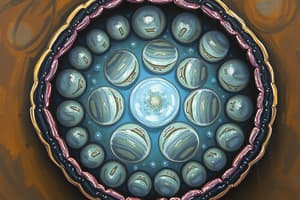Podcast
Questions and Answers
What are the three main parts of a cell?
What are the three main parts of a cell?
- Endoplasmic reticulum, Golgi apparatus, mitochondria
- Cell membrane, cytoplasm, nucleus (correct)
- Nucleus, organelles, cell membrane
- Lysosomes, peroxisomes, vacuoles
What is the function of the cytoplasm?
What is the function of the cytoplasm?
- Energy generation
- Providing a medium for chemical reactions and housing organelles (correct)
- Cell division
- DNA storage
What is the main role of the cell membrane?
What is the main role of the cell membrane?
- Maintaining cell integrity and controlling what enters and leaves the cell (correct)
- Energy production
- Facilitating cell movement
- Assisting in protein synthesis
What provides selective permeability in the cell membrane?
What provides selective permeability in the cell membrane?
Which structure separates the material inside the cell from the material outside the cell?
Which structure separates the material inside the cell from the material outside the cell?
What is the function of the mitochondrion in a cell?
What is the function of the mitochondrion in a cell?
Which organelle is responsible for modifying and packaging proteins for transport to their final destinations?
Which organelle is responsible for modifying and packaging proteins for transport to their final destinations?
What is the main function of the cytoskeleton in a cell?
What is the main function of the cytoskeleton in a cell?
Which structure is involved in the synthesis of ribosomes?
Which structure is involved in the synthesis of ribosomes?
What are lysosomes responsible for within a cell?
What are lysosomes responsible for within a cell?
Study Notes
Cell Structure and Organization
Cells are the fundamental structural and functional units of all living organisms, and they are highly organized assemblies of macromolecules that undergo continuous dynamic rearrangements. The cell consists of three main parts: the cell membrane, the nucleus, and the cytoplasm. These components provide the necessary environment for cells to perform various functions, including cell expansion, growth, and replication.
Cell Membrane
The cell membrane, also known as the plasma membrane, is a delicate structure that separates the material inside the cell (intracellular) from the material outside the cell (extracellular). It plays a crucial role in maintaining the integrity of the cell and allows for the transport of nutrients and waste products across the cell membrane. The cell membrane is composed of lipids, proteins, and carbohydrates, and it exhibits selective permeability, allowing only specific molecules to enter or leave the cell.
Cytoplasm
The cytoplasm is the gel-like fluid inside the cell, providing a medium for chemical reactions and a platform upon which other organelles can operate within the cell. It is responsible for cell movement and stability, and it houses intricate arrangements of fine fibers and hundreds or even thousands of other organelles. The major components of the cytoskeleton, which is found within the cytoplasm, include microtubules, intermediate filaments, and microfilaments. These structures are involved in various processes, such as cell movement, maintaining cell shape, and facilitating the movement of secretory vesicles through the cell.
Nucleus
The nucleus is a dense region of ribonucleic acid (RNA) in the cell and is the site of ribosome synthesis. It determines how the cell will function and the basic structure of that cell. The nucleus contains the genetic information of the cell, which allows it to reproduce its organizational and functional pattern.
Cell Organelles
In addition to the cell membrane, nucleus, and cytoplasm, cells contain various organelles that play specialized roles in maintaining cellular functions. Some of these organelles include:
- Mitochondrion: The powerhouse of the cell, responsible for energy production.
- Endoplasmic Reticulum (ER): A network of tubules and sacs that helps process and transport proteins within the cell.
- Golgi Apparatus: A series of interconnected sacs that modify and package proteins for transport to their final destinations.
- Lysosomes: Membrane-bound vesicles that contain enzymes to break down and recycle cellular waste.
- Centrioles: Short, barrel-shaped structures that aid in organizing the microtubules of the cytoskeleton.
These organelles, along with the cell membrane, cytoplasm, and nucleus, work together to enable cells to perform their various functions and maintain the overall structure and organization of the cell.
Studying That Suits You
Use AI to generate personalized quizzes and flashcards to suit your learning preferences.
Description
Test your knowledge about the fundamental structural and functional units of living organisms, focusing on the cell membrane, cytoplasm, nucleus, and cell organelles. Explore questions related to the roles and components of these vital cell structures.




